Precision Injection Molding: Make Parts with Tight Tolerance
The most popular method of producing plastic products with multiple parts that need to be assembled at the end of production is injection molding. Assembling parts entails aligning and connecting components correctly. Tolerance is crucial in this situation; improper specification and control will lead to assembly failure.
Tolerance errors are always problematic because injection molds are expensive. As a result, understanding how to regulate injection molding tolerances is essential. This article will provide an overview of how design for manufacturing (DfM) techniques such as material selection, tool design, and process control can be used to manage plastic molding tolerances.
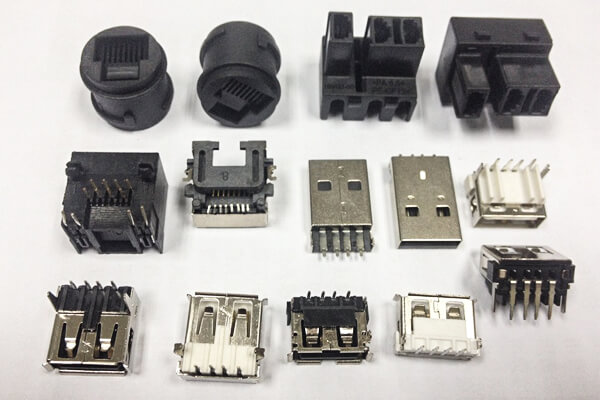
Why Tolerances Matter in Injection Molded Parts
The precision of any rapid prototyping process, including precision injection molding, is contingent upon its accuracy. While injection molding is generally precise, slight variations persist, underscoring the importance of establishing acceptable deviation ranges for effective part functionality after assembly.
In the assembly of products comprising multiple injection molded parts, plastic molding tolerances play a crucial role. Consider the scenario of joining two plastic molded parts with a bolt; precise hole drilling in both parts is essential. Any discrepancies in hole location and size can lead to errors during assembly, compromising functionality. Hence, locational tolerances on both parts are imperative to ensure optimal performance.
In essence, the control and optimization of precision injection molding tolerances involve anticipating the “worst-case scenario.” This approach entails determining permissible deviation ranges to facilitate the maximum functionality of the end products.
How to Enhance Injection Molding Tolerances
To optimize precision injection molding tolerances, consider leveraging Design for Manufacturing (DfM), selecting appropriate injection materials, refining injection mold design, and implementing robust process controls. This section will provide an overview of each category to help you achieve realistic plastic precision injection molding tolerances.
During the Design Phase
Manufacturers utilizing precision injection molding often encounter challenges such as warping, excessive part shrinking, and misalignment, all of which impact the tolerances of injection molded parts. Adhering to Design for Manufacturing (DfM) principles during the product design phase is crucial to mitigate these issues.
Overall Size
The tolerance significance increases with the overall size of the product or parts. Larger products in plastic precision injection molding may experience distortion, warping, or shrinking. Therefore, careful consideration of size is essential to minimize these effects.
Wall Thickness
Shrinkage during the cooling phase is influenced by factors like wall thickness and temperature. Maintaining uniform wall thickness reduces cosmetic defects such as warping, sinking, cracking, and twisting. Considerations for achieving uniform wall thickness include avoiding sharp internal corners, utilizing ribs for reinforcement, incorporating radii on inside corners, and selecting materials with wall thickness in mind.
Draft Angles
Draft angles aid in the easy removal of parts from injection molds, reducing friction, wear, and tear while ensuring a smooth finish. Neglecting draft angles can result in shrinkage and parts becoming stuck during ejection. Recommended draft angle considerations include 10 to 20 degrees for most parts, adding 10 degrees for every 1-inch depth, using 30 degrees for light texture, and exceeding 50 degrees for heavy texture, with 0.50 degrees on all vertical surfaces.
Bosses
Bosses, integral for fastening components during assembly, require careful design considerations. Thick boss walls can lead to voids, sink marks, prolonged cycle times, and plastic splitting during fastening. Core bosses, attaching them to the nearest sidewall, aids load distribution, improves part rigidity, and enhances material flow.
Incorporating these design considerations during the initial phases of precision injection molding can significantly contribute to achieving and maintaining precise tolerances for the final products.
Choose the Appropriate Material for Precise Injection Tolerance
The selection of the right material significantly influences precision injection molding tolerance, primarily by ensuring uniform shrinkage— the contraction of precision injection molding material during the cooling phase due to changes in density. Shrinkage is contingent on factors like wall thickness, temperature, part complexity, and the material type. When choosing materials, consider the following factors to guide your decision:
Plastic Composition
Amorphous plastics, such as ABS, exhibit lower shrinkage compared to semi-crystalline plastics like polyethylene, owing to their less compact molecular structure.
Molecular Weight
High molecular weight resins tend to have high viscosity and a greater pressure drop, contributing to an increased shrink rate.
Additives
The inclusion of fillers with low thermal expansion can effectively reduce the shrink rate.
Various resins exhibit diverse shrinkage rates, necessitating careful consideration during material selection and injection mold design. This attention to detail helps mitigate cosmetic defects like warping, sinking, cracking, and twisting, ultimately influencing the tolerance of injection molded parts.
Consider Mold Tools Carefully
Once the ideal materials are chosen, mold designers typically oversize the mold to accommodate material shrinkage, given the varying shrinkage rates associated with different materials and uneven thicknesses. When designing the mold, careful attention should be paid to the following aspects:
Tool Cooling
Cooling is a critical phase in precision injection molding, impacting the quality of the final product. Uniform cooling of the heated plastic polymer is essential to prevent issues like shrinkage, sink marks, jetting, and warping, all of which affect the appearance, tolerance, and functionality of the end product. To achieve uniform cooling, designers incorporate strategic cooling channels in the mold and monitor parameters such as injection pressure, resin viscosity, and fill time.
Tool Tolerance
Injection molds, often created using CNC machining, benefit from tight tolerances that ensure accuracy throughout the heating and cooling cycles. Maintaining tolerance is crucial for proper cooling and preventing defects like warping, shrinking, and sinking.
Ejector Pin Location
The ejector pin, responsible for pushing the final product out of the mold, should be carefully positioned to avoid unwanted indentations and defects on the finished product. Incorrect ejector pin placement, especially in non-rigid or unevenly cooled materials, can lead to cosmetic defects and physical aberrations.
Gate Location
The gate serves as the entry point for precision injection molding materials into the mold. Proper gate location is essential, considering factors such as minimizing sinking and voids, ensuring complete packing in thick-walled areas, avoiding obstructions like pins and cores, and preventing distortion in the runner and impact on aesthetics. Incorrect gate placement can result in uneven fill rates, leading to warping and shrinkage, as well as poor cosmetic finishes.
Implement Consistent Process Controls
Process controls serve as a means for manufacturers to calibrate crucial variables influencing part quality. These variables, inherent in every manufacturing process, undergo calibration to minimize deviation. Common variables encompass temperature, pressure, and holding time. Several methods to achieve this consistency include:
Sensor Integration
Embedding temperature and pressure sensors into the mold allows for real-time measurement of the mold environment. This feedback enables the implementation of repeatable process controls, ensuring consistent and precise manufacturing conditions.
Thermal Expansion Considerations
Resins, with their high thermal expansion coefficient, can undergo size alterations in response to temperature changes. Maintaining consistent temperatures while working with parts is essential to mitigate variations caused by thermal expansion, promoting uniformity in the manufacturing process.
Attainable Tolerances in Plastic Injection Molding
To achieve precise plastic injection molding tolerances, various factors are considered in the plastic mold design. Here are common tolerances applicable to major plastics used in precision injection molding:
Dimensional Tolerances (+/- mm)
Maintaining accuracy poses challenges, prompting the use of the (+/-) sign to indicate a range in measurement. Each material exhibits a distinct tolerance range as dimensions increase. The table illustrates the dimensional tolerance for key plastics in precision injection molding.
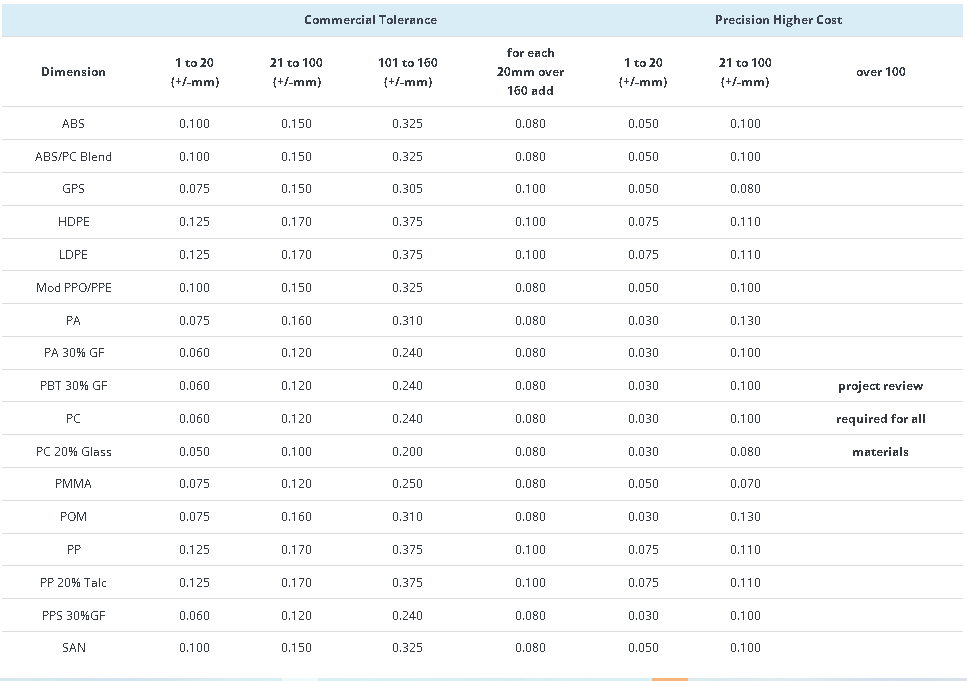
Straightness/Flatness Tolerances
Warping can result from varying mold shrinkage rates along and across the flow direction. It is influenced by different wall thicknesses, each with its shrink rate. Minimizing warping involves adjusting mold design, optimizing gate position, and exercising process control. Achieving 100% elimination of warping may be challenging, necessitating practical tolerance considerations in plastics.
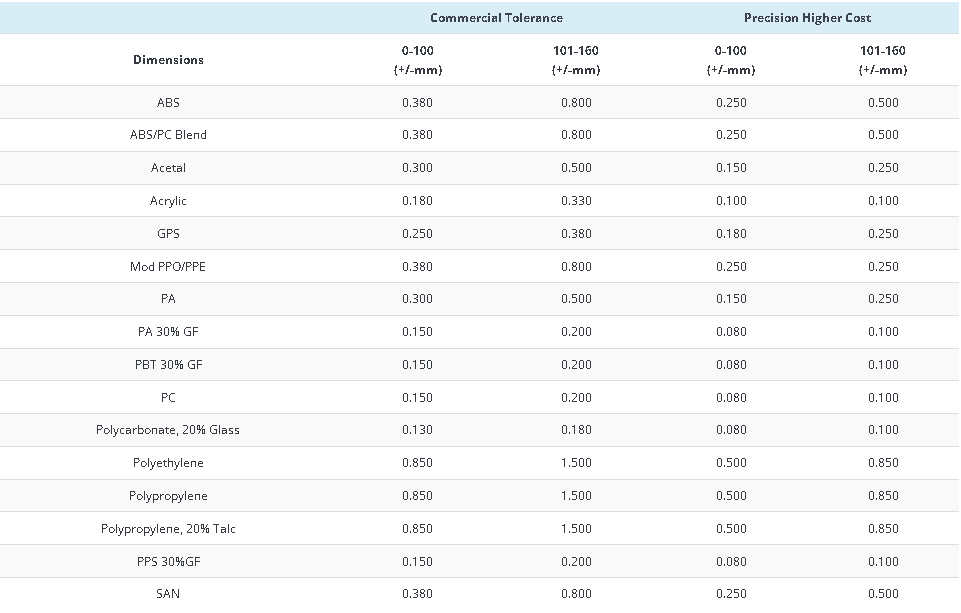
Hole Diameter Tolerances (+/- mm)
Larger hole sizes warrant careful tolerance considerations. The chart outlines explicit tolerances for various hole diameter sizes.
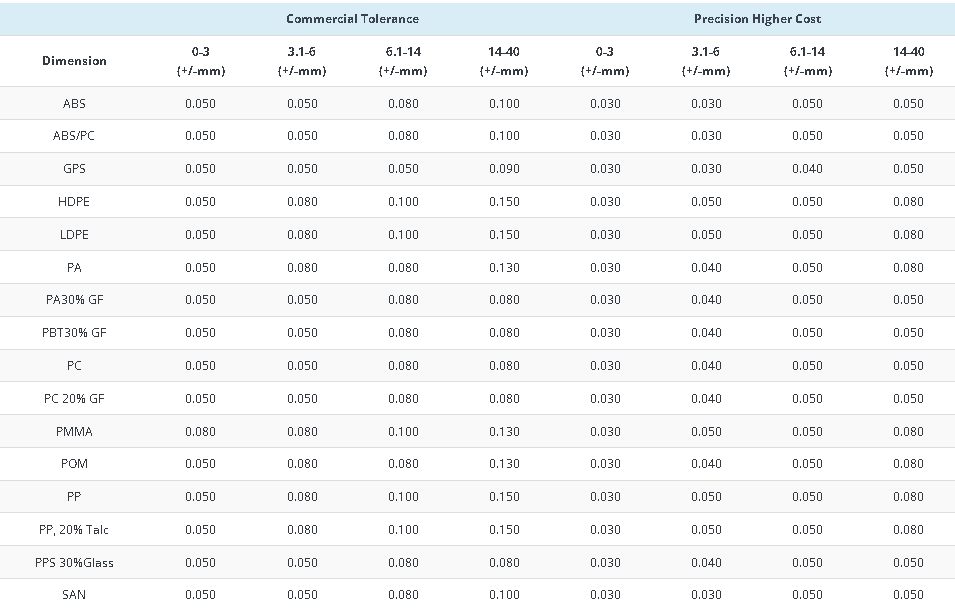
Blind Hole Depths Tolerances (+/- mm)
Blind holes, drilled without breaking through a workpiece, are prone to deformation under strong melt flow forces. The chart provides different tolerances applicable to blind hole depths.
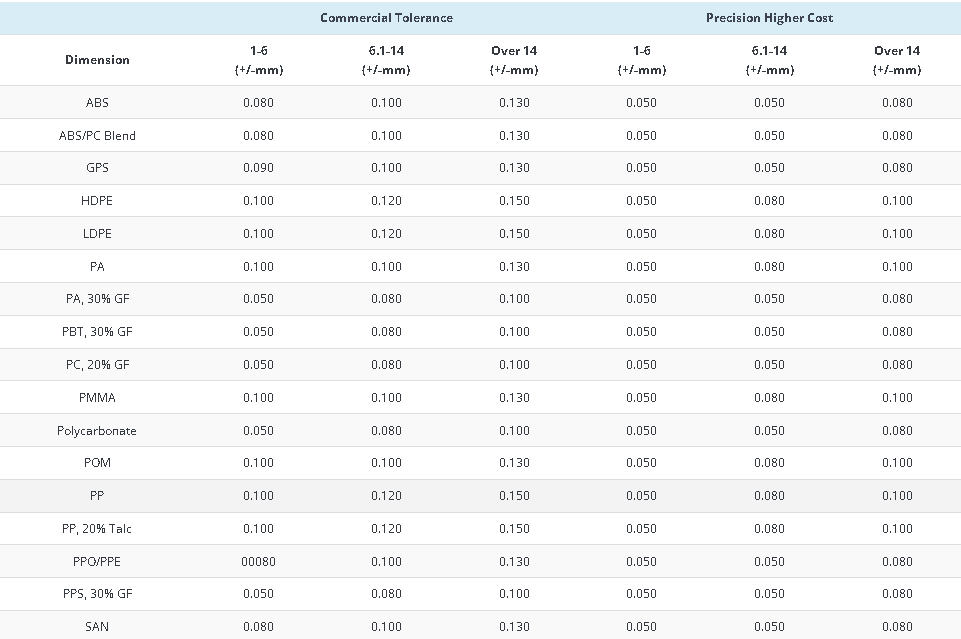
Concentricity/Ovality Tolerances (+/- mm)
Determining wall thickness involves assessing the difference between outside and inside diameters. The chart details varying tolerances and associated cost implications for achieving this level of precision.
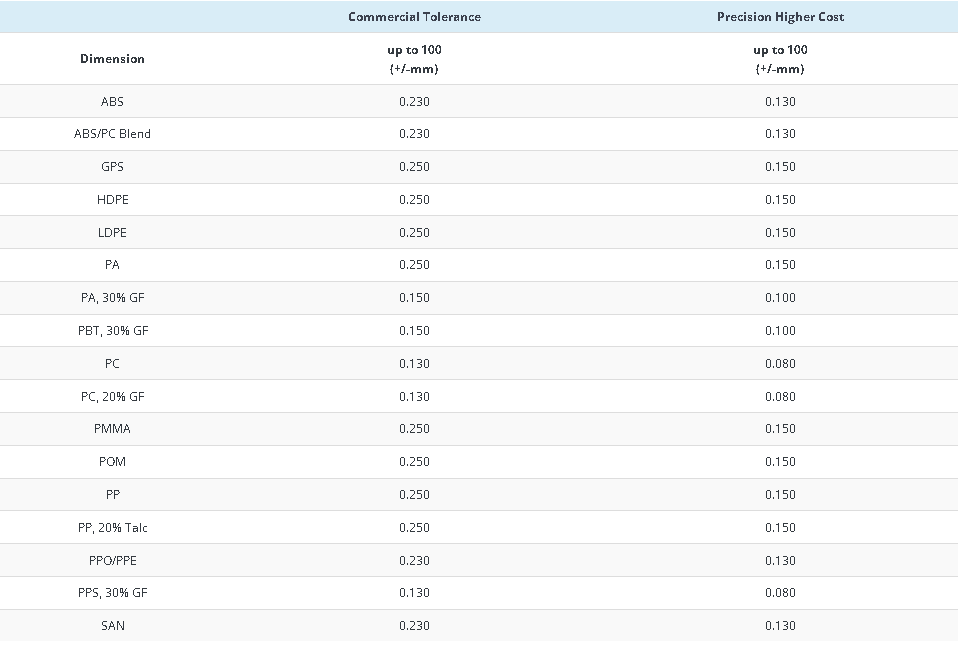
Precision Injection Molding Service
To ensure efficient functioning, precision injection molding tolerances are essential when assembling products with multiple injection-molded parts.
The allowable deviation range that promotes the best possible performance of products can be found by optimizing and managing injection molding tolerances. Typical methods for accomplishing this rely heavily on DfM, material choice, and process control; we assist you in streamlining the typical methods that will be most helpful for your project.
Targeting and minimizing injection molding variances is necessary to produce high-performing and reliable products from a variety of injection-molded parts. Quality and dependability can be achieved in parts through part optimization.
Choosing to collaborate with us can be the best choice for producing high-quality parts. We are a skilled rapid prototyping business with extensive injection molding service knowledge, as well as the tools and know-how to achieve that objective. Our team is made up of skilled workers who are dedicated to producing a top-notch product on schedule.
Please feel free to talk with us!
FAQs
1. What are the typical tolerances for injection molded parts?
Injection molds, crafted through CNC machining for high accuracy, typically achieve tolerances of +/- 0.005 inches. More restrictive tolerances are also possible, contingent on the machine’s capabilities and the team’s experience.
2. What are the effects of specifying a tighter tolerance?
Specifying a tighter tolerance in injection molding results in increased manufacturing costs. Additionally, it introduces challenges in the production and assembly of multiple parts into the final product, leading to higher labor costs and increased material wastage.
3. How accurate is injection molding?
Injection molding is highly accurate, rendering it suitable for various material fabrication. Despite some design limitations, the precision of the mold is typically within 0.005 inches. This accuracy makes injection molding a reliable method widely employed by many rapid prototyping services.
Get a free quote and design analysis today.
We’ll reply to you within 6 working hours.
We respect your privacy.
+86 139 2927 4777 (WhatsApp, Wechat)
